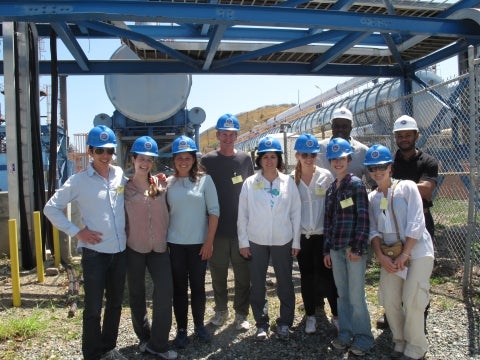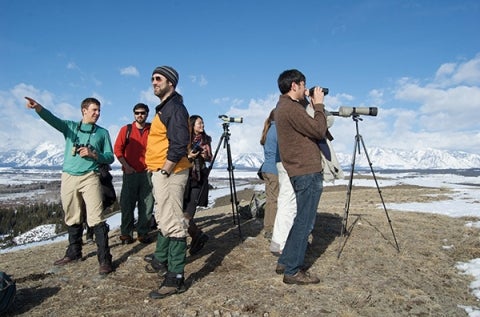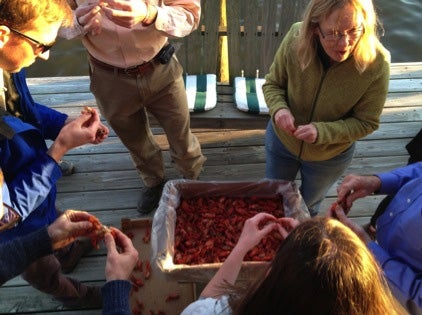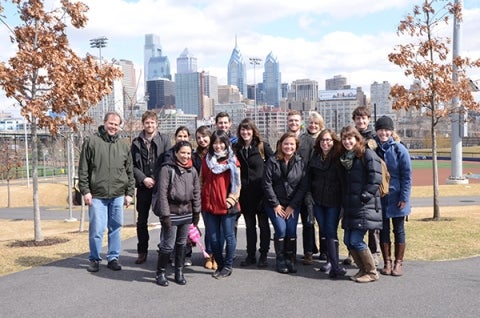Note: Yale School of the Environment (YSE) was formerly known as the Yale School of Forestry & Environmental Studies (F&ES). News articles and events posted prior to July 1, 2020 refer to the School's name at that time.
Spring "Break" means field work for F&ES students and faculty! This time away from the classroom offers students important opportunities for research across a spectrum of environmental concerns and geographical locations. Students confront global issues in real time & space, engaging with the people who must find and implement solutions.
 St. Thomas V.I.
St. Thomas V.I.
Touring a sewage plant isn’t the typical excursion when visiting St. Thomas in the U.S. Virgin Islands, but F&ES students aren’t your typical tourists. Prof. Gaboury Benoit and research scientist Mary Beth Decker took eight students to St. Thomas, and the sewage treatment plant was one of two dozen organized activities.
Students engaged representatives from community groups, nonprofits, the University of the Virgin Islands and the Department of Planning and Natural Resources to discuss management challenges in the small island context. Students took soil cores from a terrestrial ghut (seasonal water course) and sediment cores from an aquatic mangrove lagoon. The samples will be tested at Yale University for Cesium 137, a unique tracer for studying erosion and sedimentation.
The movement of soil has many different impacts on land and sea, from transporting toxins to clogging waterways and shading marine organisms. By starting on the ridges and ending on the reefs, sedimentation provides a comprehensive framework for addressing multiple environmental and development stressors.
 Jackson, Wyoming
Jackson, Wyoming
This year, 10 F&ES students traveled with Prof. Susan Clark to Jackson, Wyo., to assess conservation in the Greater Yellowstone Ecosystem. They compared and contrasted scientific, management and policy dynamics while exploring themes of leadership, problem solving, decision-making, governance, change and adaptation.
Students based their considerations on their meetings with representatives of the U.S. Fish & Wildlife Service, the U.S. Park Service at Grand Teton National Park, the U.S. Forest Service at the Bridger-Teton Forest, the Bureau of Land Management, the Wyoming Game & Fish Department, as well as nonprofit groups including the Jackson Hole Conservation Alliance, the Jackson Hole Land Trust, the National Museum of Wildlife Art and the Northern Rockies Conservation Cooperative.
 Hawaiian Islands
Hawaiian Islands
One of three Industrial Ecology student groups (pictured here with Prof. Marian Chertow Ph.D. '00) spent a week on Molokai, an island of about 7,000 people. Their project focused on identifying available natural resources to increase cattle and pig production for local consumption and export. Ideally producers will utilize food and farm waste from the island or nearby Oahu and expand use of an existing slaughter facility on the island.
Another group of Industrial Ecology students traveled to Hawaii Island. They spent most of their time in the Ka'u region, gathering information about resource inputs and outputs and proposed biofuel feedstock cultivation in order to conduct comparative life cycle assessments for future land uses. The students met and spoke with a dozen different stakeholders – from farmers and ranchers to various county department officials and University of Hawaii cooperative extension specialists. Their study will be completed in May 2013 and assist the community of Ka'u and the Hawaii County Regional Planning and Agriculture Department's plan for regional economic development.
 Southern Forests
Southern Forests
F&ES faculty Ann Camp M.F.S. '90 and Michael Ferrucci continued a 40-plus year tradition when they traveled with 11 students to tour southern U.S. forests and operations—the famed Southern Field Trip. Viewing and discussing forestry and forest management with practitioners, they toured a paper mill, a pole mill and a sawmill in Alabama to better understand logging operations.
The group also visited Florida’s Blackwater State Forest and met with the nonprofit Longleaf Alliance to learn about wildlife and sustainable forest management. And of course, the group enjoyed the comforts of Southern hospitality all along the way.
 Haiti
Haiti
A field trip to Haiti included students from the Yale Schools of Nursing, Public Health and Forestry & Environmental Studies. This group established a learning collaboration with the Hôpital Albert Schweitzer (HAS). HAS is located in Deschapelles, in the Artibonite Valley region, with a catchment area of over 340,000 people living within the 610 square mile service area. The students researched opportunities and challenges faced by Haitian partners when dealing with environmental problems such as deforestation or drought, and public health issues such as malnutrition and chronic diseases. The class interacted with other institutions and individuals as well, including visits to the new University Hospital in Mirebalais and the Regional Public Hospital in Hinche, thanks to collaboration with Partners in Health (PIH). Meetings with Fulbright fellows (and Yale alums) working in the Health Ministry and the Prime Minister’s office offered deeper discussions around governance of public policy.
Locally led initiatives on sustainable farming and higher agricultural education for Haitians in the central plateau underscored the importance of environmental restoration and health. The agroforestry team met with the Haiti Timber Re-Introduction Program (HTRIP) technicians during a poster session (pictured here).
 Eastern Cities
Eastern Cities
Professors Brad Gentry and Mark Ashton M.F. '85, Ph.D. '90, led 13 F&ES students on a five-day tour and investigation of green infrastructure planning and implementation efforts in Philadelphia, Baltimore and Washington, D.C. The tour featured numerous site visits of bioswales, tree pits, infiltration trenches and stream restoration sites in various stages of completion and functionality, as well as presentations by engineers, city planners and nonprofit program managers engaged in green infrastructure in the three cities.
The investigation is part of a capstone seminar from which the students will compile and write the green infrastructure portions of a stormwater management plan for the Yale campus in conjunction with the Yale Office of Sustainability and Yale Facilities.
Published
May 3, 2013